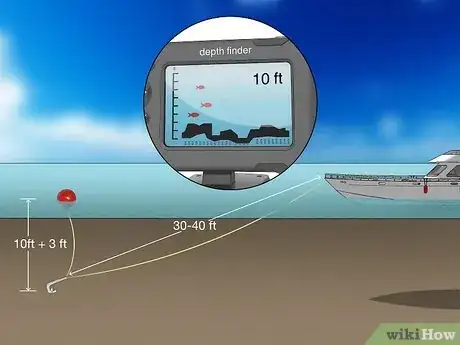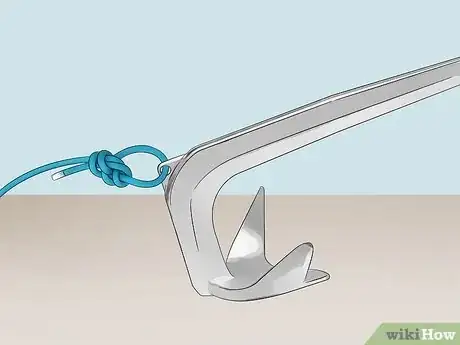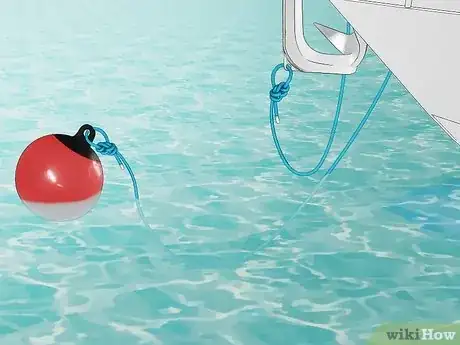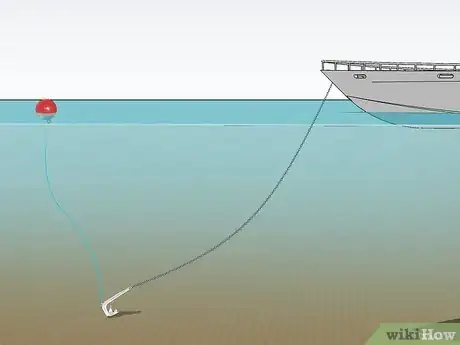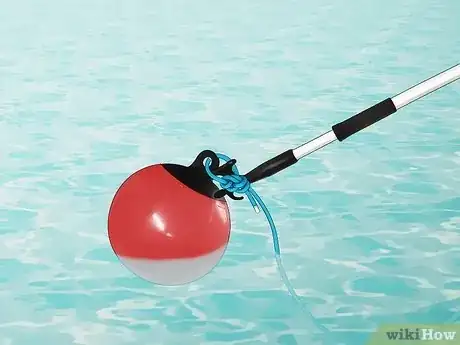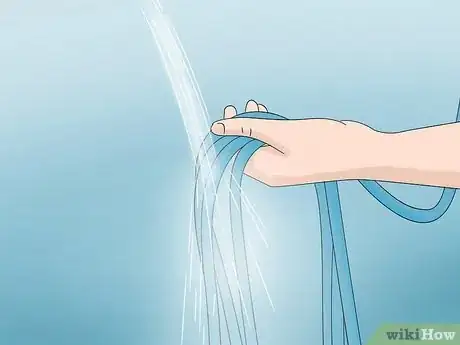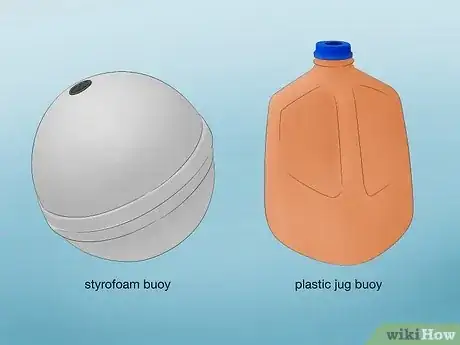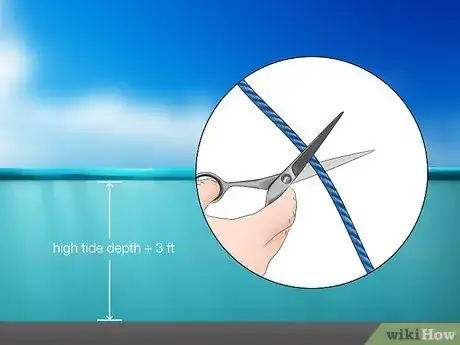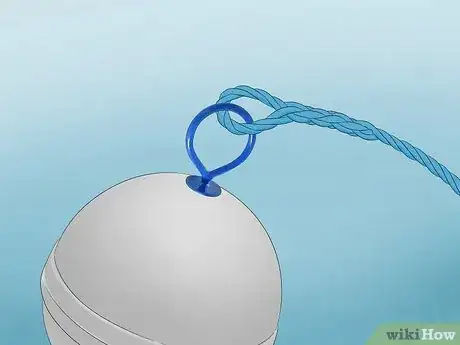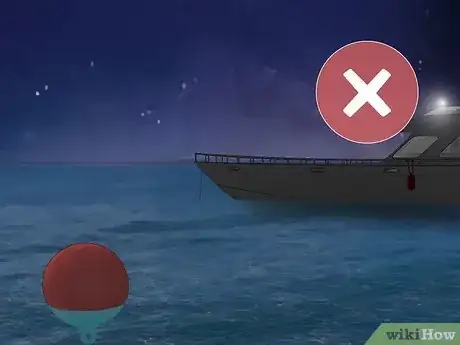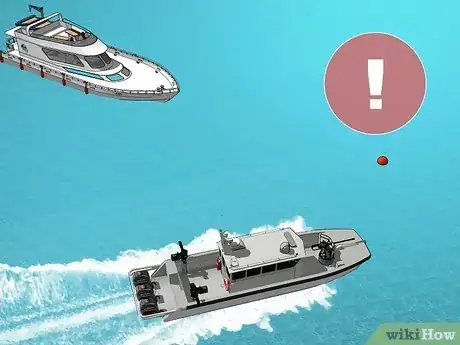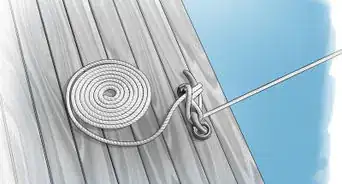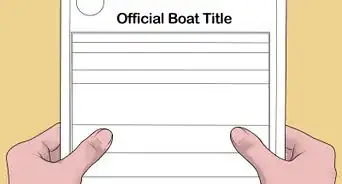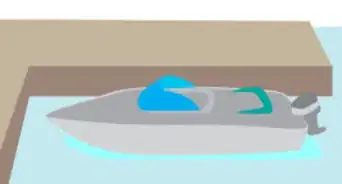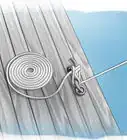This article was co-authored by Nitzan Levy. Captain Nitzan Levy is a Sailor, Social Entrepreneur, and the Founder of Sailors NYC, a recreational sailors’ club based in Jersey City, New Jersey that specializes in cruising boats and a variety of community programs. Capt. Levy has over 20 years of sailing experience and has sailed in many places around the world including: the Atlantic Ocean, the Mediterranean Sea, The Caribbean, and the Indian Ocean. Capt. Levy is a U.S. Coast Guard Licensed Master of vessels up to 50 Tons with Auxiliary Sail and Assistance Towing Endorsements. Capt. Levy is also a NauticEd Level V Captain Rank Chief Instructor, an American National Standards Assessor, an SLC instructor, an ASA (American Sailing Association) Certified Instructor Bareboat Chartering, and an Israeli licensed skipper on Boats for International Voyages.
This article has been viewed 20,266 times.
An anchor buoy is the common term for a trip line.[1] Anchors can be expensive, but you can save yourself this cost with a homemade trip line. If you already have one, they're relatively easy to deploy and retrieve. Be sure to use your trip line safely to prevent unnecessary tangles or damage.
Steps
Deploying and Retrieving a Trip Line
-
1Determine the length of your trip line. Use a nautical chart, a depth finder, or another suitable instrument to find the water's depth at high tide. The length of your trip line needs to be at least equal to this depth.
- You never know when you'll get tall waves because of rough conditions. Account for this by adding about 3 ft (.91 m) to your minimum length for the line.[2]
- Avoid allowing too much extra line in the water, as this can make it more likely to foul. Extra slack can be wrapped around the buoy's bottom.
- If you'll only be anchored for a short time, use a 1:3 or 1:4 ratio for your line. For instance, if the depth where you are is 10 ft (3.0 m), you'd need to pay out 30–40 ft (9.1–12.2 m) of chain.[3]
- If you'll be staying longer, use a 1:7 ratio. For example, if you'll be at the same spot with the 10 ft (3.0 m) depth but you'll be staying overnight, you'd need 70 ft (21 m) of chain.[4]
-
2Fasten the trip line to the anchor. The cord of your trip line needs to be firmly attached to the crown of the anchor. Most anchors will have at least a hole in the fluke or a designated tie-on spot for trip lines.
- If the hole on your anchor for your trip line is rough, you'll need a shackle so the line doesn't chafe and break.[5]
- If your buoy is not already attached, use a firm knot, like a large eye splice, to fasten it to the anchor-opposite end of the rope.
Advertisement -
3Spool out the trip line to prevent snags and tangles. Gather the cord of the trip line in a coil so it's easier to manage. If necessary, pass the coil under and over the pulpit or rail to prevent it from snagging there. Separate the coil in half and set down the half farther away from the float.[6]
-
4Deploy the trip line. Approach your anchorage point carefully. While keeping ahold of the half of the coil closest to the float, toss the float overboard to the anchorage point. Release the line as you do, so it completely streams into the water.[7]
-
5Follow the trip line with the anchor. Take care during this process to avoid getting the trip line and anchor tangled. Lower the anchor as you would normally.[8] Make sure to deploy the trip line before dropping anchor, as this will decrease the chances of tangling.[9]
-
6Retrieve the trip line and anchor. Approach the anchor point with your boat. Snag and retrieve the buoy of your trip line with a boat hook. Retrieve the anchor as per usual – you'll only need to use the trip line if the anchor is stuck.[10]
- If your anchor doesn't budge, it's time to put your trip line to work. In many cases, simply pulling up on the trip line will capsize the anchor and free it.[11]
- Most anchors resist a single direction of travel. By adding slack to the anchor line or by pulling in the direction opposite anchor's resisted direction, you may pop stuck anchors free.[12]
-
7Maintain and stow your trip line. Once the anchor's on board, it's time to remove the trip line from the crown. After using your trip line, you should rinse it well in clean water. Allow the wet line to air dry completely, then return it where it belongs in the anchor locker.[13]
Making a Simple Trip Line
-
1Purchase or make a buoy. Even a cheap Styrofoam buoy from your local hardware store should work for a trip line anchor buoy. Serious boaters or those who frequent deep waters might benefit from sturdier buoys purchased from boat supply stores.
- Make an upcycled buoy from a clean plastic jug. You can even paint the jug a bright color to make it easier to spot in the water.[14]
-
2Cut polypropylene cord for the buoy. Not only will polypropylene line withstand harsh conditions better than most other kinds of cordage, it also floats. The length of your trip line should be about 3 ft (.91 m) longer than the highest tide in your sailing area.
- Choose a bright color of polypropylene cord so you can spot your trip line better in unfavorable conditions.[15]
- After cutting the rope, prevent it from fraying at the cut end with glue or by passing a the flame of a lighter over the cut end to melt it.
-
3Attach the buoy to the line with a large eye splice. Large is the key word here. A large eye splice will make snagging your buoy a cinch with a boat hook. If you decide to use another kind of knot, make sure it's sturdy. Your trip line won't do you much good if the buoy floats away.[16]
Using Trip Lines Safely
-
1Write a label on your buoy. Especially in crowded conditions, boaters desperate for moorage might take liberties with unmarked buoys. Send a clear message that your buoy is currently in use by writing “Trip line, don't pick up” in large letters, along with your boat's name.
-
2Avoid using trip lines overnight. In the dark, even the most colorful trip lines can be missed. This can tangle in a fellow boaters' propellers, causing trouble for you both. Especially if there's night traffic on the water, you may want to forego a trip line for overnight anchorages.[17]
-
3Prevent boats from damaging your anchor with a trip line. Crowded harbors can be difficult places to maneuver. This can sometimes cause other boats to pass uncomfortably close to your anchor and its line. Improve visibility of your anchorage point for other boats with a trip line.[18]
-
4Use a trip line when anchoring in areas with a poor bottom. Broken rock or large pieces of coral can trap your anchor stubbornly in cracks and crevices. If you've had your anchor stuck before in the area you're now anchoring, or if you're worried it might get stuck, deploy a trip line.[19]
Expert Q&A
-
QuestionHow can I safely anchor a boat?
 Nitzan LevyCaptain Nitzan Levy is a Sailor, Social Entrepreneur, and the Founder of Sailors NYC, a recreational sailors’ club based in Jersey City, New Jersey that specializes in cruising boats and a variety of community programs. Capt. Levy has over 20 years of sailing experience and has sailed in many places around the world including: the Atlantic Ocean, the Mediterranean Sea, The Caribbean, and the Indian Ocean. Capt. Levy is a U.S. Coast Guard Licensed Master of vessels up to 50 Tons with Auxiliary Sail and Assistance Towing Endorsements. Capt. Levy is also a NauticEd Level V Captain Rank Chief Instructor, an American National Standards Assessor, an SLC instructor, an ASA (American Sailing Association) Certified Instructor Bareboat Chartering, and an Israeli licensed skipper on Boats for International Voyages.
Nitzan LevyCaptain Nitzan Levy is a Sailor, Social Entrepreneur, and the Founder of Sailors NYC, a recreational sailors’ club based in Jersey City, New Jersey that specializes in cruising boats and a variety of community programs. Capt. Levy has over 20 years of sailing experience and has sailed in many places around the world including: the Atlantic Ocean, the Mediterranean Sea, The Caribbean, and the Indian Ocean. Capt. Levy is a U.S. Coast Guard Licensed Master of vessels up to 50 Tons with Auxiliary Sail and Assistance Towing Endorsements. Capt. Levy is also a NauticEd Level V Captain Rank Chief Instructor, an American National Standards Assessor, an SLC instructor, an ASA (American Sailing Association) Certified Instructor Bareboat Chartering, and an Israeli licensed skipper on Boats for International Voyages.
Sailing Instructor Make sure the depth where you're anchoring is sufficient for your boat. For example, if your boat is a 4 1/2 foot draft, the water should be deeper than that. You'll need to account for the tides, as well—and the difference between high tide and low tide can be 6-7 feet, so take that into consideration.
Make sure the depth where you're anchoring is sufficient for your boat. For example, if your boat is a 4 1/2 foot draft, the water should be deeper than that. You'll need to account for the tides, as well—and the difference between high tide and low tide can be 6-7 feet, so take that into consideration.
Things You'll Need
Deploying and Retrieving a Trip Line
- Anchor
- Trip line (and buoy)
Making a Simple Trip Line
- Buoy (or a clean plastic jug)
- Polypropylene cord
- Scissors (or a knife)
- Tape measure
Warnings
- Before you anchor your boat in an area, be sure there's plenty of distance between you and any other boats or other obstacles. Your boat will swing around while you're anchored, and you don't want to crash into anything.[20]⧼thumbs_response⧽
References
- ↑ http://cruising.coastalboating.net/Seamanship/Anchoring/TripLines.html
- ↑ http://cruising.coastalboating.net/Seamanship/Anchoring/TripLines.html
- ↑ Nitzan Levy. Sailing Instructor. Expert Interview. 24 April 2020.
- ↑ Nitzan Levy. Sailing Instructor. Expert Interview. 24 April 2020.
- ↑ http://www.gulfcoastsailingschool.com/uploads/4/6/8/6/46860537/anchoring_using_trip_line.pdf
- ↑ http://www.gulfcoastsailingschool.com/uploads/4/6/8/6/46860537/anchoring_using_trip_line.pdf
- ↑ http://www.gulfcoastsailingschool.com/uploads/4/6/8/6/46860537/anchoring_using_trip_line.pdf
- ↑ http://www.working-the-sails.com/mooring_and_anchoring.html
- ↑ http://www.gulfcoastsailingschool.com/uploads/4/6/8/6/46860537/anchoring_using_trip_line.pdf
- ↑ http://www.working-the-sails.com/mooring_and_anchoring.html
- ↑ http://www.gulfcoastsailingschool.com/uploads/4/6/8/6/46860537/anchoring_using_trip_line.pdf
- ↑ http://cruising.coastalboating.net/Seamanship/Anchoring/TripLines.html
- ↑ http://www.gulfcoastsailingschool.com/uploads/4/6/8/6/46860537/anchoring_using_trip_line.pdf
- ↑ http://www.gulfcoastsailingschool.com/uploads/4/6/8/6/46860537/anchoring_using_trip_line.pdf
- ↑ http://www.gulfcoastsailingschool.com/uploads/4/6/8/6/46860537/anchoring_using_trip_line.pdf
- ↑ http://www.gulfcoastsailingschool.com/uploads/4/6/8/6/46860537/anchoring_using_trip_line.pdf
- ↑ http://cruising.coastalboating.net/Seamanship/Anchoring/TripLines.html
- ↑ http://www.gulfcoastsailingschool.com/uploads/4/6/8/6/46860537/anchoring_using_trip_line.pdf
- ↑ http://www.gulfcoastsailingschool.com/uploads/4/6/8/6/46860537/anchoring_using_trip_line.pdf
- ↑ Nitzan Levy. Sailing Instructor. Expert Interview. 24 April 2020.
